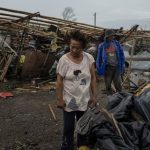Typhoon Mangkhut: 14 killed as storm batters Philippines
Some 14 people have been killed in a massive storm which brought destruction to the northern Philippines, a presidential adviser says.
Typhoon Mangkhut ripped through the Philippines’ main island of Luzon, and is now moving west towards China.
The storm tore off roofs, felled trees, triggered 42 landslides and caused extensive flooding.
Mangkhut unleashed winds of 185km/h (115mph) as it careered from east to west across the north of Luzon.
Five million people were in its path, and thousands were evacuated.
How bad is the damage?
Almost all buildings in the city of Tuguegarao – the capital city of the north-eastern Cagayan province – sustained some damage, a government official said, and communications were down in places.
Francis Tolentino, a political adviser to President Rodrigo Duterte, said up to 14 people were killed as a result of the storm.
Two rescuers died trying to help people trapped in a landslide. Unverified reports say the body of a young girl was found in the Marikina river, which flows through Manila.
The mayor of the Baguio City said five people were killed there. Mauricio Domogan told CNN Philippines a similar number were also missing and the sewerage system was being overwhelmed by the floodwaters.
The evacuation centre in the coastal town of Aparri is said to have been destroyed and phone networks are down.
The typhoon recalls memories of the deadliest storm on record in the Philippines – Super Typhoon Haiyan in 2013 – which killed more than 7,000. However, preparation and evacuation procedures have been improved since then.
The typhoon made landfall at Baggao, in the north-east of the Philippines, at about 01:40 local time on Saturday (17:40 GMT on Friday).
However, the head of the disaster management agency, Ricardo Jalad, said no-one was reported killed in Baggao.
After losing some of its wind speed over land as it headed west, the storm was downgraded from a super typhoon and is now travelling with wind speeds equivalent to a category four hurricane.
The storm – known locally as Ompong – has a cloud diameter of about 900km and is heading west at about 30km/h.
The World Meteorological Organisation (WMO) billed the storm as the strongest tropical cyclone the world has faced so far this year.
The Philippine Red Cross shared footage of rising flood waters and winds ripping through towns on Saturday morning.
The typhoon has now left the Philippines and is forecast to pass near Hong Kong on Sunday afternoon.
Authorities there have urged residents to stay indoors when the storm approaches. Weather experts say it may be the strongest tropical storm to hit the territory in decades.
In nearby Macau, shops have been boarded up and residents have been sticking tape on their windows.
The typhoon is expected to weaken into a tropical depression by Tuesday.
How prepared was the Philippines?
Authorities in the Philippines have said they were better prepared for the storm than in previous years.
Warnings were issued in dozens of provinces. Travel by sea and air was restricted.
Flights were cancelled, schools shut and the army was on standby.
“We are really frightened,” Delaila Pasion, who had fled her home, told AFP news agency. “They say it is so strong, we were too scared to remain.”
“During previous monsoon rains, half of our house was destroyed so I wanted to take my grandchildren to safety,” she told journalists.
The Philippines is routinely hit during the typhoon season.
In China, where the storm is predicted to hit late on Sunday or early on Monday, the authorities have raised storm alerts to “yellow”, which is the second level on the four-tier warning system.
High-speed rail services have been cancelled in parts of the south, local media report.
Is Hong Kong in danger?
Mangkhut may be classed as a super typhoon, again, by the time it passes, or hits, Hong Kong on Sunday.
At its current rate, forecasters say it could be the strongest typhoon they have seen since they started making records in the 1940s.
Residents have been preparing. Tape has been stuck to the windows, creating ominous X-shapes on the front of homes and offices, and some bamboo scaffolding also appears to have been taken down or secured as a precaution.
This is a place used to preparing for approaching storms but they know this one is big, says the BBC’s Robin Brant.
However, officials are taking no chances. They have asked people to stay indoors.
Antoine Li, a government official at an emergency centre in the village of Tai O on the western coast of Hong Kong’s Lantau island, said residents must not underestimate the storm.
“This typhoon will be very dangerous as it will arrive when everyone is sleeping and there is no way to leave. So we have called on residents to leave the village before it gets dark,” he told Reuters news agency.
A shop owner in the village said: “Everyone is scared of the typhoon this time, very scared”, and they are more worried about the elderly living in stilt houses, who insisted on staying.
IMAGES:
Fishermen in China’s Guangdong province remove their boat from the water in preparation for the arrival of Typhoon Mangkhut, 15 September 2018 Image copyright GETTY IMAGES
Image caption Fishermen in China remove their boat to safety as the typhoon approaches
Image caption Some residents of Aparri were still able to amuse themselves
Residents inspect damage in Alcala, Philippines, after Typhoon Mangkhut battered the north, 15 September, 2018 Image copyright GETTY IMAGES
Image caption Residents inspected damage in Alcala
Residents play in waves in Aparri, Cagayan province, after Typhoon Mangkhut, 15 September 2018 Image copyrightEPA
Residents in an evacuation centre in the Gonzaga, Philippines, as Typhoon Mangkhut battered the north, 15 September, 2018 Image copyright GETTY IMAGES
Image caption Residents of Gonzaga province after a night in an evacuation centre
For more on this story and video go to: https://www.bbc.com/news/world-asia-45532217










